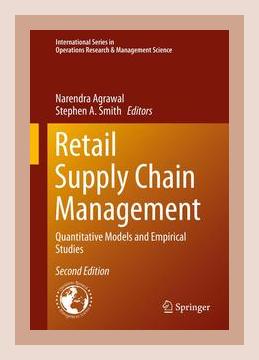Operations and Supply Chain ManagementService Operations
k “Retail Supply Chain Management: Quantitative Models and Empirical Studies” by Nils Rudi and Hau Lee, which focuses on advancing the understanding of retail supply chains through quantitative models and empirical studies.
Table of Contents:
- Introduction
- Inventory Management and Optimization
- Demand Forecasting
- Supplier Relationship Management
- Supply Chain Coordination
- Case Studies and Examples
- Conclusion
1. Introduction
The book primarily delves into the intricacies of retail supply chain management, emphasizing the importance of quantitative models and empirical studies. It lays a foundation for understanding how different aspects of the supply chain can be optimized to improve overall performance.
Key Action:
– Familiarize yourself with the basic principles of supply chain management and gain a foundational understanding of quantitative modeling.
2. Inventory Management and Optimization
A significant portion of the book addresses inventory management, exploring various models that retail managers can use to optimize their inventory levels. The authors discuss Economic Order Quantity (EOQ), Just-In-Time (JIT), and Vendor Managed Inventory (VMI) systems.
Concrete Example:
– The application of EOQ in a retail environment helps determine the optimal order quantity that minimizes total inventory costs, including holding, ordering, and stockout costs.
Key Actions:
– Implement EOQ calculations for your inventory to determine how much stock to order and when.
– Evaluate the feasibility of JIT systems to minimize holding costs by synchronizing orders with demand.
3. Demand Forecasting
The book stresses the importance of accurate demand forecasting in retail supply chain management. Several forecasting techniques are explored, including time-series analysis, causal models, and qualitative methods.
Concrete Example:
– Using time-series analysis, a retail chain was able to predict seasonal demand patterns and adjust its inventory accordingly, thereby reducing stockouts and surplus inventory.
Key Actions:
– Utilize historical sales data to develop a time-series model that can forecast future demand.
– Integrate causal models that consider external factors like economic indicators or marketing campaigns.
4. Supplier Relationship Management
Effective supplier relationship management (SRM) is identified as a critical component for ensuring supply chain efficiency. The book discusses strategies for selecting and maintaining relationships with suppliers, emphasizing the benefits of long-term partnerships.
Concrete Example:
– A major electronics retailer improved lead times and reduced costs by forming strategic alliances with key suppliers, enhancing communication, and sharing forecasts.
Key Actions:
– Develop a set of criteria for evaluating potential suppliers, focusing on reliability, lead times, and cost.
– Establish collaborative processes with your suppliers to share demand forecasts and production plans regularly.
5. Supply Chain Coordination
The authors delve into the complexities of coordinating different parts of the supply chain. Concepts such as centralized versus decentralized decision-making, the bullwhip effect, and the role of information sharing are analyzed.
Concrete Example:
– A retail clothing company mitigated the bullwhip effect by implementing a centralized demand information system, which improved coordination across its supply chain.
Key Actions:
– Examine your supply chain for signs of the bullwhip effect and implement strategies such as better demand forecasting or centralized information systems to reduce it.
– Consider centralizing decision-making to streamline processes and improve supply chain responsiveness.
6. Case Studies and Examples
Throughout the book, various case studies are presented to illustrate the application of quantitative models in real-world scenarios. These case studies highlight both challenges and successes faced by retailers.
Concrete Example:
– The case of a grocery retailer that used simulation models to optimize its warehouse layout, resulting in a 15% reduction in picking times and a corresponding increase in throughput.
Key Actions:
– Use simulation models to experiment with different warehouse layouts and identify the most efficient design.
– Emulate best practices from successful case studies in your own supply chain operations.
7. Conclusion
The conclusion synthesizes the key points discussed throughout the book, re-emphasizing the need for the integration of quantitative methods and empirical research in retail supply chain management.
Key Action:
– Continuously pursue advanced training and education in quantitative supply chain management and stay updated with the latest empirical research to enhance your capabilities.
This summary encapsulates the essence of “Retail Supply Chain Management: Quantitative Models and Empirical Studies” by Nils Rudi and Hau Lee. By applying the strategies discussed in the book, individuals and organizations can significantly improve their supply chain efficiency and effectiveness.
If you have any further questions or need more details, feel free to ask!
